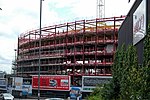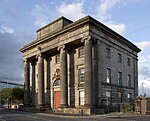Birmingham Curzon Street railway station (formerly Birmingham station) was a railway station in central Birmingham, England. Initially used as a major early passenger terminus before being eclipsed by newer facilities and converted into a goods depot, it was a continuously active railway facility up until 1966.
The station was jointly built and operated by the London and Birmingham Railway (L&BR) and the Grand Junction Railway (GJR), being the meeting point between the two railways, as well as the terminus for the first intercity line to be built into London. As such, it served as a joint terminus for the scheduled passenger trains of both companies to major destinations such as London, Manchester and Liverpool, between 1838 and 1854. It was formally opened on 24 June 1838, and received its first train from London on 17 September of that year. Being incapable of permitting through trains, it quickly proved to be inadequate even after expansion efforts to accommodate longer trains. Thus, during the 1840s, the newly-created Midland Railway opted to build a larger and more suitable station, Birmingham New Street, half a mile away from the earlier station that would take over most of its passenger traffic in 1854.
During the 1850s, Curzon Street station found a new role handling freight traffic; conversion work was undertaken between 1860 and 1965 to turn it into a dedicated goods station. In addition, limited passenger traffic, such as special excursion trains, called at that station up until its closure to passengers in 1893. It was heavily used for railway freight into the British Rail era, only being closed to rail-based goods traffic in 1966. Many original features were demolished at this time, such as the platforms and trainshed, but the principal entrance building survived and was given Grade I listed status. While much of the site continued to be used for road-based parcel traffic, the principal building was used as office space for various purposes, including the occasional art event. During the 2010s, it was announced that the site and the principal building would be reused and integrated into the new Birmingham Curzon Street railway station, and host the high speed services on High Speed 2.









